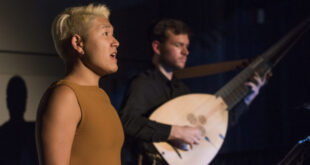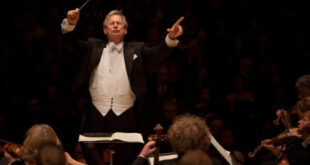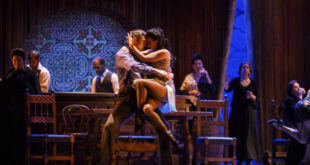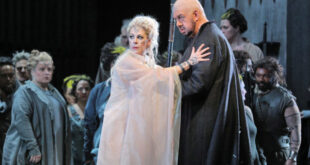The opening night performance of Donizetti’s “Anna Bolena” heralded the best all-around production of an Italian opera staged thus far this season by Chicago’s Lyric Opera. I was a bit surprised, because historically, typical Bel Canto works like this one are treated a little like orphans or grumpy uncles — “You’re welcome to sit at the table, but please, take a seat at the other end!” But then again perhaps “Anna Bolena” is not all that typical a Bel Canto opera after all. While most definitely a “number” opera (that is, one vocal or choral stand-alone piece strung together one after another) and certainly a bravura showpiece for a great prima donna (of which Lyric’s cast can boast), it is also a pretty good historical drama set to music with many interesting ensembles and unexpected splashes of instrumental color.

“Historical drama?” you may be asking. “THIS opera?” I know — when you read a synopsis of it there seems to be little connection between the plot and real-life historical events. But all the historical divergences are employed to great dramatic effect. In the operatic version, Enrico (Henry VIII), in order to make his latest paramour, Giovanna (Jane Seymour) his new queen, uses the honest human feelings of Smeton (Anna’s music teacher and private singer), Rochford (Anna’s brother) and Ricardo (Lord Percy, Anna’s former lover and husband), to unjustly accuse Anna (Anne Bolelyn) pf all kinds of illicit sexual acts, incest and treason — all punishable by death. You can’t beat that for high drama!
For the curtain proper of “Il trovatore,” Lyric’s production featured a Goya painting that I felt was totally appropriate for the drama. The beginning and second act of “Anna Bolena” was preceded by an opaque scrim that bore only one image in its center — a large depiction of the Tudor Rose, conceived by Henry VII (Henry VIII’s dad) to symbolize the union of the Lancasters and the Yorks, combining the Red and White Roses respectively. This was incredibly interesting to me, as one of my personal favorite historical interests is how the English Reformation impacted the struggle between the Catholic Church and the Lutheran (or Protestant) Reformation. (Luther took his famed “Luther Rose” from the so-called “Tudor” Rose.) And what goes on in this opera, with the future Elizabeth I toddling about, changed the course of history as few things do!
When I first learned that Sondra Radvanovsky would be singing the title role, I was expecting that the production could turn out to be one of her and “others.” (Not that I would be that upset about it, because I absolutely LOVE the way she sings — especially Verdi!) Fortunately, Radvanovsky was teamed up with a fine cast of outstanding singers, so the performance was definitely NOT top-heavy. Nevertheless she WAS the prima donna and gave the audience an exciting coloratura soprano ride! From her opening “Afflitta è ver son io,” she was just great, and she simply thrilled with her top-off of the “pezzo concertante” to end Act I. But what brought the crowd to its feet in a wild outburst of applause was the legendary mad scene with its quote of “Home Sweet Home” and highlighted by “Un suon sommesso” in the finale.
This is a very demanding role for a soprano — it requires singing throughout in solos and ensembles, and the toughest, most strenuous passages come at the end. So the singer must deliver the force and pizzazz that is expected and STILL has to have the salt to finish things off with the devilishly difficult mad scene. Sondra Radvanovsky was more than up to the challenge. It was a pleasure and an honor to hear her and I would go so far to say that right now, I know of no better soprano in the world! It’s a real joy to hear that Lyric has signed her as Norma in the future.
Another Christmas present for me was the fine singing of bass John Relyea as Enrico, who has sung before at Lyric in a French opera, and who sings a lot at the Met, but whom I had never heard before. He’s a REAL bass, not a baritone or a bass-baritone, and the dark color of his voice is perfect for the dark machinations of his character.
Next in line for me in excellence of singing was mezzo Kelley O’Connor who played the pants role of Smeton. Many who do not know me personally will think me an old fuddy-duddy when I say that these roles always make me feel a bit — well, queasy or uneasy — even Mozart’s Cherubino or Verdi’s Oscar. But now I think that it’s all in the way that the part is sung, and Ms O’Connor made the absolute most of the part AND a fan out of ME!
Here I need to note that I rarely read anyone praising Donizetti as an instrumentalist or orchestrator, but I will right now. In every opera of his that I know, there is always SOME kind of instrumental solo that is surprising and beautiful. Here, accompanying Smeton’s first-act aria “Deh! non voler costringere” (sung beautifully by Ms O’Connor), is a gorgeous and technically difficult harp part that was played to perfection by Marguerite Lynn Williams.
Bryan Hymel, as Ricardo (Lord Percy), showed himself to be a solid “Bel Canto” tenor with a strong high register, and mezzo Jaime Barton was superb in her portrayal of Giovanna (Jane Seymour). The fine Lyric Opera Orchestra was well directed by conductor Patrick Summers.
 Fra Noi Embrace Your Inner Italian
Fra Noi Embrace Your Inner Italian






